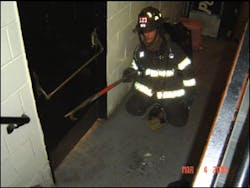Firefighters must be aggressive, but safe when conducting an interior search. The first thing that the interior search team must do is find the fire and if possible confine it. This is done to allow the engine company to know the location of the fire before the line is committed. It is difficult to overcome a hoseline stretched to a wrong location at a fire. Once the fire is located and the engine company has water and is attacking the fire, then members can branch off and do a primary search for victims of fire. What tool would you bring on the search team?
The halligan tool is one of the most versatile tools in the fire service. When using halligan tool, firefighters have a number of options on how to search with this tool. Firefighter searching with a halligan tool may search with the fork out or with the adz end out. This is dependent on what way you were taught to search. The preferred way to search might be to use the adz and point end facing down, forming a triangle on the searching surface. The member should then place a hand on the bar just ahead of the fork. This method of search has an advantage to the member searching as it does two things to assist with the search. First, it allows the member searching to keep their finger off the ground, allowing for a quicker search by sliding the tool along the area being searched. Second, this technique allows the searching firefighter to feel any changes in the search area. If the searching firefighter strikes their fingers on the ground, then the firefighter has encountered a stairway or possibly a hole in the floor. Either way, the member should move forward slowly with an extended hand or turn and probe the area with an extended leg. This will allow a complete evaluation of the hazard before deciding to continue the search or if a collapse has been encountered and you must immediately leave the area. This way to search has an added benefit of being safer for the member performing the search, by keeping the point and adz of the halligan on the ground and not pointing up. This is safer because if the searching firefighter stumbles when searching and falls forward the dangerous and sharp parts of the tool are pointing toward the ground, thereby reducing the risk of injury. The firefighter must remember to slide the tool along the search area and not lift it off the ground while doing a search. The possible risk to civilians by the tools is avoided by sliding the tool and, if the search is now done faster, then it will be a benefit to those trapped civilians.
The axe is another tool that firefighters might use as a search tools. When searching with this tool, the searching firefighter should hold the axe at the handle just below to head. This will allow the firefighter to swing the tool and not risk injuring a civilian. This also gives the searching firefighter more control over the tool because if the axe is dropped the tool will not fall away from the firefighter. If a firefighter encounters a stairway with the head of the axe forward, then the axe might be lost down the flight of stairs; by reversing the axe, this might be avoided.
The last tool that might be brought in on a search is a hook. Some members bring a three-foot closet hook and some bring a six-foot hook. The three- foot closet hook has the main advantage of being shorter and easier to search with. The six-foot hook allows for more reach and will allow members to be able to do more with the tool during pre- and post-fire overhaul. If members have a difficult time, have them carry the six-foot hook about three feet back and run over the wall and the floor.
Searching above or adjacent to a fire is one of the most dangerous operations for firefighters. Remember to always bring a pressurized water can with you for protection (see “Tip #9,” July 2004). That tool in conjunction with your other tools and your knowledge of how to use them might be the only thing between escaping a hazardous environment and getting injured. Always bring a tool or tools and know how to perform an effective search with that tool.
Michael M. Dugan will present “Hands-On Training: Engine & Truck Company Operations,” “How to Hold an Effective Company Drill” and “Truck Company Operations: Tricks of the Trade” at Firehouse Expo 2005, July 26-31 in Baltimore.Michael M. Dugan, a Firehouse® contributing editor, is a 20-year veteran of the FDNY, serving as a captain of Ladder 123 in Brooklyn’s Crown Heights. He is former volunteer firefighter in the Halesite, NY, Fire Department. Dugan has been involved with the fire service for 27 years and is a hands-on-training instructor at Firehouse Expo and Firehouse World. While assigned as a firefighter in Ladder Company 43, Dugan received the James Gordon Bennett Medal in 1992 and the Harry M. Archer Medal in 1993, the FDNY’s highest awards for bravery.





